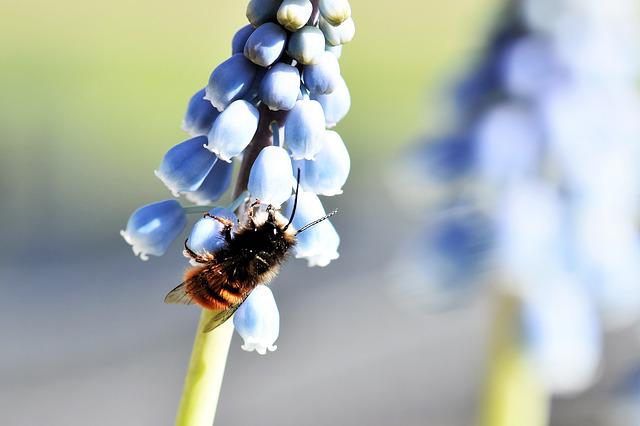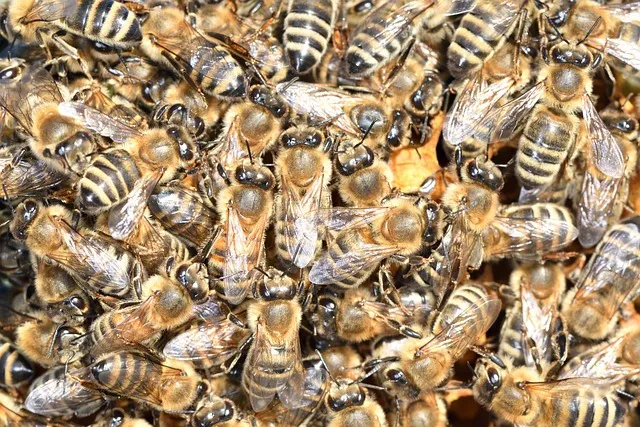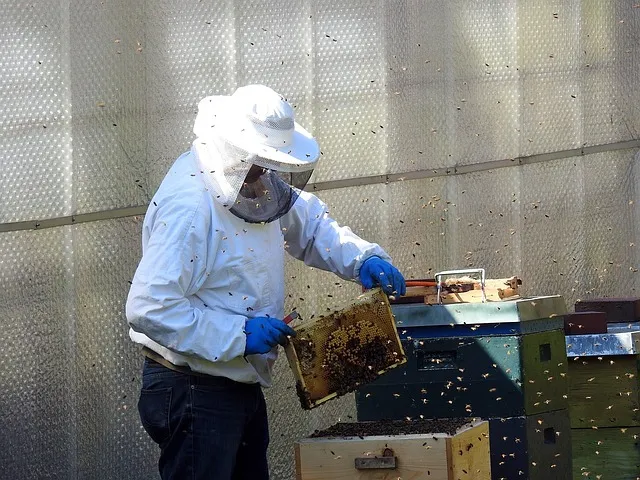Do mason bees make honey?
When we think of beneficial insects that help to pollinate our gardens, honey bees come to our minds. Their sweet and rich product also makes them rule the insect kingdom. However, there are diverse species of bees that exist. Some of them, like mason bees, are more effective pollinators than honey bees. These fabulous insects are rising in popularity with gardeners and farmers. Surprisingly, before honey bees were introduced in the US, mason bees did all the pollination work.
Similar Articles you may like to read –
How to Identify Honey Bees? Honey Bee Identification Guide
Is taking honey from bees cruel?
How to start a honey bee farm? What setup is needed?
How many times a year can you get honey from a hive?
What are Mason Bees?
The Mason bee is a beautiful native bee found in most parts of the USA. They are metallic blue or blue-black in color and resemble large flies. Like the honey bees, they have five eyes, six legs, and four wings. Their name originates from their nest-building behaviour; once they lay eggs, they seal the cells with a mortar-like mud application. Unlike the honey bees, all the females lay eggs, and each one makes her own nest. The males are smaller than females and don’t possess a stinger. The female mason bees only sting when trapped or squeezed, making them perfect for home gardens. They pose little or no threat of stinging.
While in the world, the mason bees lay eggs in small natural cavities such as hollow stems, woodpecker holes, and insect holes. They lay eggs on holes drilled into wooden blocks, paper straws, or cardboard tubes in an artificial setting. They cannot excavate their nesting cavities and are usually glad to find suitable locations. Do mason bees make honey?
Mason bees do not make honey. However, they collect pollen and nectar, just like the honey bees. They consume nectar and pollen as they forage. They don’t keep food reserves because the adult bees die before it gets cold. Mason bees overwinter as pupae that emerge when it gets warm in spring.
This is What Makes Mason Bees Better Pollinators than Honey Bees
Mason bees pollinate flowers in early spring before other pollinators join the task. They are out in the fields at a temperature of 13 degrees centigrade. They fly around a 100 meters radius; hence they benefit flowers within a closer range than bees. They successfully pollinate 95% of the flowers they visit, while honey bees have a 5% pollination rate. Since they are not aggressive, it is easy to integrate them into urban areas.
Amazingly, 250-300 female mason bees can effectively pollinate a whole acre of cherries or apples. It is estimated that a single mason bee can do the task of about 75 honey bees. Here is what makes them good pollinators.
- Unlike the honey bees, they possess scopia hairs (branched hairs) located on their underside, which they use to collect pollen. These specialized hairs collect more pollen than honey bees, and when they land on flowers, they splash more effectively.
- They are messy pollinators, spreading pollen everywhere, and don’t bother to clean much like honey bees. Honey bees store pollen in pollen baskets meaning less pollen will reach other plants.
- They are not choosy and crash into any flower, rubbing their bodies throughout the bloom. As they move from flower to flower, they collect a lot of pollen and transfer it to numerous flowers.
While honey bees play a significant role in commercial pollination, mason bees are good in fruit trees and backyard gardens. Since honey bees live in colonies, hives can be transported from one farm to another for pollination. This is usually a robust business renting out bees. They also fly for miles in search of food resources. However, research is ongoing on using solitary bees in large-scale operations. With the increasing decline of honey bee populations, there is a raised attention to solitary bees for pollination.
Flowers that Attract Mason Bees
Mason bees prefer tube-shaped flowers with irregular shapes. Some of their favourite flowers include willows, scorpion weed, mints, thistles, and penstemon. They also love plants from the legume family, such as clover, indigo bush, and vetch.
Some species of mason bees specialise in plants in the Rosaceae family. These include cherries, apples, pears, plums, peaches, blackberries, almonds, etc. These plants blossom early in spring and can’t get enough pollination from honey bees. Mason bees can work even on cold spring mornings.
Do mason bees live in colonies?
Mason bees are solitary insects. However, they prefer to build nests next to each other. Artificial nesting chambers favour this trait. Each female serves as a worker bee and a queen (foraging for food and laying eggs). She mates with a male mason bee lays eggs and dies about eight weeks later.
Do mason bees sting?
Like the honey bees, only the female mason bees possess a stinger. The chances of a mason bee stinging are very low- they only sting when squeezed. Their sting feels like a pinch or a mosquito bite and carries very little venom. It is also challenging for them to penetrate human skin. The stinger is not a barbed sting and can sting you severely.
The Life Cycle of a Mason Bee
Depending on the location, Mason bees mainly start to appear in early spring( March or April). They mate after emerging from the nests and immediately begin to forage for pollen and nectar. Like the honey bees, the males die soon after mating. The females also start to search for new nests. If she finds a clean tube, she will use it immediately. If she comes across a tube that was used before, she will clean it first.
After the new home is ready, she starts depositing pollen and nectar from the end. He transforms pollen and nectar into a roughly shaped ball. When there is enough food for a larva, she lays an egg and seals it with mud. She has control over the eggs she lays- for females, she lays fertilized eggs, while for males, she lays unfertilized eggs.
Once done, she moves to the next cell and repeats the process of creating a partition for each egg until the channel is full of compartments. This process can proceed to June when they begin to die out. The eggs hatch into larvae which start consuming the reserved food ( pollen –nectar masses).
A larva will go through the entire process inside a cell. It moults 4 to 5 times. Each tube produces more females than males, increasing the potential of a larger bee population the following year. Around August, they spin a cocoon and slowly transform into an adult mason bee. In autumn, the insect looks like an adult bee but remains in the cocoon throughout the winter. They emerge in spring when temperatures are favourable to them. Interestingly, eggs destined to be female mason bees are deposited at the far end, so the males appear first.
How to Attract Mason Bees into Your Garden

In early spring, you can attract these exceptional pollinators to your garden using a mud source, abundant food resources, and nesting tunnels. You can make their house from hollow reeds, wood, or thick paper straw. The best way to make a tunnel on the wood is by using a sharp drill bit to ensure the holes are free from splinters. You should not drill to the end since the bees can’t use such holes. (6mm).
There is also a wide variety of mason bee nest boxes sold in gardening centers and other online companies. You can also opt to buy from them. After setting a home for them, leave them to pollinate and fill the hollow tubes with cells.
Solitary bees are less susceptible to diseases and pests since they live independently and work for themselves. Here is how to go about it.
How To Raise Mason Bees
Choose a Perfect Location for Mason Bee Nests

- The nests should be mounted securely on a tree, fence, or a side of a building 4-7 feet from the ground to offer protection from the moisture. This is also an excellent height to observe the bees. Avoid a place with a swinging tree because they don’t like dappled shade.
- Choose a location that receives warm morning sun (east or south-facing spot). They need warmth to start their day’s task and dry tunnels to propagate.
- Offer protection from wind and rain
- Ensure there is a mud source nearby (within 50 feet)
- Ensure there are spring blooming plants with abundant pollen within 200-300 feet. This ensures the bees do not waste time and energy foraging for food. Consider plants that bloom during the bee’s entire foraging season. This ensures the females lay eggs to their full potential.
Collecting Cocoons
The mason bee season ends when tunnels are sealed with mud. You can opt to move the capped tubes to a safe location to prevent parasitism and predation. Ensure you use a breathable bag and store it in a warm place shielded from disturbance. You can also choose to leave the tubes undisturbed until fall cocoon harvest. While they may do well on their own, harvesting and cleaning the cocoons is a perfect way to prevent parasites and diseases from spreading.
You harvest the cocoons by opening the tubes and scrapping out the nesting materials. Then proceed to sort out the cocoons from the debris. It is advisable to carry out this task in a cool place. A warm environment may wake up the bees from their dormant state.
Selecting and Cleaning the Cocoons
You should only choose healthy cocoons. Separate the c-shaped cocoons and those with small holes. C-shaped cocoons are likely to be affected by a fungal spore disease known as chalkbrood, while wasps have parasitized those with holes. Wash the healthy cocoon in a cold water bath. Those that sink in water should also be removed. Dry the cocoons well so that they don’t rot.
Protecting the Cocoons in Winter
Store the cocoons in a dark place during the cold winter season. You can keep them in a refrigerator between 30 to 40 0 F and maintain an enclosure of around 60% humidity. Allow them to stay like this throughout the winter until the temperatures are 500F(13 degrees centigrade).
In early spring, before the onset of spring-blooming flowers, return the cocoons in your garden. Place them outside near their nest to start another season. As the days warm up, you will see the bees steaming in and out of the nests. The presence of mud-plugged holes indicates that a new batch of pollinators is on the way for the next season.
It is recommended to release the cocoons in two waves to extend the spring pollination season. The second half should be released after two weeks. Be sure to release both males and females in the two groups. Male cocoons are larger than female cocoons.
Tips for Attracting Mason Bees in Your Garden
- Mason bees lay eggs in tubes, inside reeds, etc., and seal them with clay. Keep a spot in your garden with wet clay exposed to ease their work.
- When making a nest for them, use good reeds or tubes. Choose those that can be opened to retrieve the cocoons so that they are not trapped inside.
- Try as much as possible to retain them in your property or garden. If these native bees fly to forage far, they might not come back. It is not advisable to use plastic straws or bamboo. You can buy reusable tubes that can be opened and cleaned.
- Protect your bees from birds like woodpeckers that can prey on them.
- Mites affect the mason bees. Ensure to clean up their cocoons since they enter their houses or cocoons.
- Mason bees love a place with many flowers. Ensure there are sufficient flowering plants, wildflowers, bushes, and gardens. It is also advisable to avoid hybrid plants. These produce less nectar and pollen with a low quality. The right location with all their needs will encourage them to take residence.
Is Mason Beekeeping Costly?
With some knowledge and a few supplies, you can start propagating and raising your mason bee population. They occur naturally over a broad geographical region. When they find a nest or a clean tube with a perfect shape and size, they move right in.
You do not require costly bee suits or hives and are not afraid of aggression. With honey bees falling prey to colony collapse disorder, solitary bees like mason bees are rising in popularity.
Do mason bees make comb?
Mason bees don’t make wax comb like a honey bee colony. They search for minute tube-shaped holes(8mm), about the size of a pencil. They then create sections in the tube. Each section contains pollen and an egg. Different sections are closed up with mud.
They first collect enough pollen, place it in a tube section, lay up an egg, and close it with mud before moving to another section. A female mason bee lays about 15-20 eggs in her lifetime.
More articles you may like to read –
How to start a honey bee farm? What setup is needed?
Is beekeeping profitable? How much can l make in a year?
How much does it cost to start beekeeping? How much do honey bees cost?
How to do bottle beekeeping? Mason Jar or plastic bottle beekeeping
Do mason bees compete with honey bees?
Species living in the same environment and using the same resources will compete with each other. Research shows minimal competition between some native and managed bees and high competition in others. The result depends on seasons and geographical areas.
Where to Buy Mason Bees
The best and easy way to incorporate mason bees in your garden is to buy a mason bee kit. The kits are most effective when set at the start of spring. Each kit contains all the tools that you require to start mason beekeeping.
FAQs
What do mason bees eat?
Like the other types of bees, they feed on pollen and nectar. They also pile up the same in their nests for their larvae. They do this before laying eggs.
When are mason bees active?
They are active in spring after emerging from their nests. They pollinate fruits and flowers during this season.
Are mason bees dangerous?
Mason bees are not dangerous, nor are they known for stinging. They are the most gentle bee species that can help you to pollinate your garden effectively. They only sting when squeezed.
What happens to mason bees in winter?
Mason bees don’t overwinter as adults. In fall, they die out and leave the larvae in cells that pupate and emerge in early spring.
Do mason bees help farmers to make more food?
Yes, mason bees not only start pollinating crops in early winter while other bees are not ready for the task but also do the job very effectively.
How do mason bees carry pollen?
Mason bees collect and carry pollen with specialized hairs known as scopia located on their abdomen.
What are mason bees good for?
Mason bees are famed for their pollination work. They start their pollinating work in early spring when it is still cold.
What is the lifespan of a mason bee?
Male mason bees die after emerging from cocoons and mating with the females. Females live for about eight weeks and die after laying eggs for the following spring generation.
What is the name of a baby mason bee?
Baby mason bees are known as larvae. They hibernate throughout winter and emerge in early spring.




